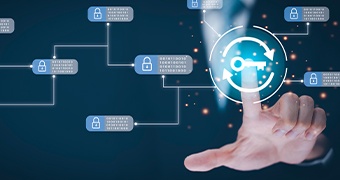The main purpose of Cybersecurity Awareness training course is to minimize huma....
Understanding the Impact of Largest Data Breaches

In the age of digital transformation, data breaches have become one of the most significant threats to businesses and consumers alike. With each passing year, the scale and sophistication of these breaches grows, leaving a trail of compromised personal information and eroded trust.
This article delves into some of the largest data breaches in history, their profound impact, and the lessons learned in safeguarding against future cyber threats.
A Closer Look at the Largest Data Breaches
The biggest-ever hack, known as the "mother of all breaches" (MOAB), has 26 billion compromised user passwords and personally identifiable information (PII) in a database. The collection, which was uncovered by cybersecurity researchers, contains information from well-known websites like Weibo, LinkedIn, Twitter, and more, raising fears about identity theft and cyber-attacks. This disclosure follows another data dump, which may have shared some records with MOAB.
A significant cyber breach originating from China made headlines as one of the most significant cybersecurity incidents of the year, exposing the data of one billion Chinese citizens for more than a year.
Two datasets on Facebook users were exposed on an unsecured cloud server, with over 530 million user records, including account names, Facebook IDs, and some passwords.
An estimated 885 million records were disclosed online, including bank account numbers, bank statements, mortgage records, social security numbers, and images of driver's licenses.
The personal information of approximately 500 million guests was compromised, including contact details, passport numbers, and travel information.
Aadhaar, India's national ID database, reportedly exposed the personal information of over one billion registered Indian citizens, including their fingerprints and iris scans.
Personal information, including social security numbers, birth dates, addresses, and in some cases drivers' license numbers, of 143 million consumers were exposed.
Yahoo experienced two massive data breaches, with the first one affecting all three billion accounts. It included names, email addresses, phone numbers, birth dates, encrypted passwords, and, in some cases, security questions and answers.
eBay reported a cyber-attack that exposed names, addresses, dates of birth, and encrypted passwords of all of its 145 million users.
Target's breach resulted in the theft of information from 70 million customers as well as information from approximately 40 million credit and debit card accounts.
A SQL injection was used to install spyware on Heartland's data systems and expose 130 million credit card numbers.
Economic and Social Impacts of Data Breaches
Direct Financial Losses
Data breaches can have staggering financial implications for both organizations and individuals. Companies face direct costs associated with breach mitigation, legal fees, and compensations, alongside indirect costs like loss of business and diminished share value. For individuals, the risk of identity theft and financial fraud can have long-lasting financial consequences.
Erosion of Trust and Reputation Damage
Perhaps more damaging than the financial impact is the erosion of trust and reputation that companies face following a data breach. Rebuilding consumer confidence can take years and requires significant investment in security enhancements and customer service improvements. Losing customer loyalty and trust can be very harmful for organizations in highly competitive markets.
Regulatory and Policy Changes
In response to the rising tide of data breaches, governments worldwide have introduced stricter data protection regulations, such as the General Data Protection Regulation (GDPR) in Europe and the California Consumer Privacy Act (CCPA) in the U.S. These regulations aim to improve data security practices and give consumers more control over their personal information. Organizations must navigate these regulatory waters carefully to avoid substantial fines and legal challenges.
Strategies to Prevent Data Breaches
Organizations must recognize the significance of safeguarding sensitive information and prioritize the implementation of preventative strategies to mitigate the risks associated with data breaches.
Technological Safeguards
In today's digital ecosystem, deploying advanced technological safeguards is crucial. Encryption, firewalls, and anti-malware tools form the first line of defense, securing data at rest and in transit. However, as cyber threats evolve, so must our defenses. Artificial Intelligence (AI) and machine learning are now being harnessed to predict and counteract cyber-attacks before they can cause harm. These technologies can analyze patterns and detect anomalies in data usage, enabling preemptive security measures. Furthermore, multi-factor authentication (MFA) has become a standard practice, adding an extra layer of security by requiring multiple forms of verification before granting access to sensitive information.
Human Factors and Education
Technology alone cannot shield against cyber threats; human error remains one of the largest vulnerabilities. Phishing attacks, for instance, exploit human psychology rather than system flaws. Therefore, comprehensive cybersecurity training for all employees is essential. Regular training sessions can educate staff on the latest cyber threats and the importance of maintaining strong passwords, recognizing phishing emails, and securely handling customer data. Cultivating a culture of security awareness within an organization can significantly reduce the risk of data breaches caused by human error.
Policy and Governance
Effective data management and privacy policies are foundational to cybersecurity. Implementing strict access controls ensures that sensitive information is only accessible to those who need it to perform their job functions. Regular security audits and compliance checks can help identify vulnerabilities before they are exploited by attackers. Additionally, establishing clear protocols for responding to data breaches can significantly mitigate their impact. This includes not only technical responses but also communication strategies to inform affected parties and regulatory bodies in a timely and transparent manner.
The Road Ahead - Navigating Future Cyber Threats
Predicting Future Vulnerabilities
As digital technology advances, so do the opportunities for cybercriminals. The Internet of Things (IoT), with its ever-growing network of connected devices, presents new challenges for data security. Each connected device represents a potential entry point for hackers. Predicting and securing against vulnerabilities in this interconnected landscape will require ongoing vigilance and innovation. Similarly, as more organizations adopt cloud computing, ensuring the security of cloud-stored data is paramount.
Innovations in Cybersecurity
The future of cybersecurity lies in innovation. Blockchain technology, for instance, offers a new paradigm for secure, decentralized data management. By encrypting data into blocks that are then chained together and distributed across a network of computers, blockchain makes unauthorized access or alteration exceedingly difficult. Additionally, quantum computing, although still in its initial stages, promises to revolutionize encryption methods, potentially rendering current hacking techniques obsolete.
The Role of International Cooperation
Cyber threats know no borders, making international cooperation essential in the fight against cybercrime. Sharing intelligence on emerging threats, collaborating on developing new security technologies, and harmonizing regulatory frameworks can enhance global cybersecurity resilience. Multinational agreements and task forces dedicated to cybersecurity can facilitate such cooperation, ensuring a unified front against cyber threats.
Conclusion
In the digital age, data breaches pose a significant threat to individuals and organizations alike. Understanding the magnitude of past breaches and their impacts is crucial for developing effective prevention strategies. By leveraging technological safeguards, fostering a culture of security awareness, implementing robust data governance policies, and preparing for future threats with innovation and international cooperation, we can navigate the digital storm more safely. As we move forward, vigilance, adaptability, and collaboration will be our best tools in securing our digital world.
How Can PECB Help?
As a global provider of education, certification, and certificate programs, PECB aims to help you demonstrate your commitment and competence by providing you with valuable education, evaluation, and certification against internationally recognized standards.
ISO/IEC 27005 is a crucial standard in the realm of cybersecurity, offering organizations a structured framework for managing information security risks effectively. By providing guidelines for risk assessment and treatment, ISO/IEC 27005 empowers organizations to identify, analyze, and prioritize potential threats to their information assets.
Through systematic risk assessments, organizations can proactively identify vulnerabilities in their systems and processes, allowing them to implement targeted controls and safeguards to prevent data breaches. Additionally, ISO/IEC 27005 promotes a risk-based approach to decision-making, enabling organizations to allocate resources more effectively and focus on addressing the most critical security risks. By incorporating ISO/IEC 27005 into their cybersecurity practices, organizations can enhance their resilience to cyber threats and minimize the likelihood and impact of data breaches.
A PECB ISO/IEC 27005 certification will give you competitive advantage in the ever-evolving field of information security. The PECB ISO/IEC 27005 certification program is globally recognized and will help you become a highly competent professional in the field.
Other PECB training courses that could be helpful include:
- ISO/IEC 27001 Information Security Management System
- General Data Protection Regulation (GDPR)
- Ethical Hacking
- Penetration Testing Professional
About the Author
Vlerë Hyseni is the Digital Content Specialist at PECB. She is in charge of doing research, creating, and developing digital content for a variety of industries. If you have any questions, please do not hesitate to contact her at: content@pecb.com.


